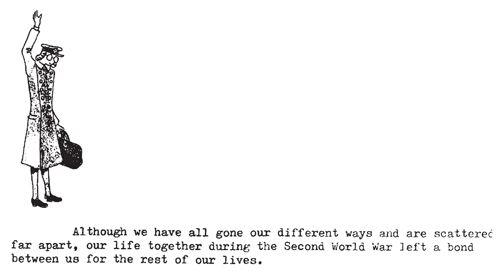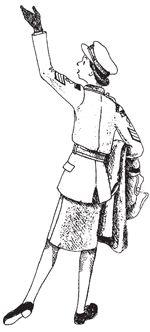Women of Intelligence: Winning the Second World War with Air Photos (45 page)
Read Women of Intelligence: Winning the Second World War with Air Photos Online
Authors: Christine Halsall

The end of Mary’s wartime service is told in her diary entries for October 1945, in a way familiar to many other servicewomen:
1st – Due for demob on October 10th.
9th – Went to Marlow with Nancy Hayes for a last coffee at The Dutch Café. Final pay at Medmenham, 3 shillings. Went to say goodbye to ‘V’ Section and moved to the transit hut.
10th – Demobbed at Wythall. Left ‘Med’ for Wythall at 7.45 am. Commenced demob about 2 pm. All happened so quickly one didn’t quite know what one was doing.
11th – Can’t realise I’m really ‘out’.
12th – Went to National Registry Office – got identity card, coupons, ration book etc. In the afternoon Mother and I went shopping and I bought myself a rather nice brown suit. The price broke me for a time – but gosh – to be a civvy!!!
30th – Dyed my RAF cardigan successfully.
17
The 800 or so women who had worked with air photographs at RAF Medmenham, and all the other women who had served in similar ways on reconnaissance and interpretation units in Britain and overseas, could be proud of the part they had played in one of the Second World War’s great achievements. From a few lumbering aircraft and a handful of civilians in 1939, photographic reconnaissance and interpretation had become the major provider of intelligence used in virtually every wartime operation. Unusually for those times, women had carried out the same work as men, were chosen for a particular job solely on their capabilities and had played a decisive part in winning the war. Mary Harrison summed up the effect of war on women:
It gave women freedom and equality to do jobs that only men did before. It taught us tolerance and how to get on with others.
Many of the Medmenham women had served for nearly six years, some had lost husbands and fiancés, and most knew of a colleague who had not returned from the conflict. They were demobilised into a country scarred and worn from the war and some faced a struggle to find employment and housing. All were affected by more stringent rationing than in wartime and shortages of just about every commodity. A significant number married and took the decision to set up new homes in America and Canada. Many years after the war Mollie Thompson wrote: ‘We just wanted to get back to normal.’


Joan ‘Panda’ Carter sketched the ATS waving goodbye to their colleagues at the end of the war. The sentiments expressed would be echoed by most women who worked with air photographs in the Second World War.
As soon as the European war ended, some sections at Medmenham closed and in 1946 the Central Interpretation Unit moved to RAF Nuneham Park and was renamed the Joint Air Reconnaissance Intelligence Centre (JARIC). On 17 July 1946, a number of wartime PIs gathered together and formed the Medmenham Club, with the primary objective of preserving the friendships made during the war.
For nearly thirty years Danesfield House was used as an RAF Signals Unit, before being sold in 1977 to Carnation Foods as their corporate headquarters. It opened as Danesfield House Hotel in 1991, since when the management has welcomed the return visits of many of the men and women who worked there in wartime. Golden wedding anniversaries, ninetieth birthdays and other notable occasions have been celebrated in the rooms where stereoscopes, maps and photographs were once used.
In 2010 the BBC used Danesfield House Hotel to film ‘wartime scenes’ as part of their documentary
Operation Crossbow
, which told the story of the hunt for the V-weapons. A celebratory Medmenham Club tea was held in the Versailles Room, where Second Phase had worked, and afterwards members and guests stepped out on to the terrace to admire the gardens and river, just as the PIs of many nations had during the war. Then, thanks to the BBC, everyone, including men and women who had worked at Medmenham in wartime days, enjoyed a spectacular flying display by a Spitfire, and WAAF PI Suzie Morrison was reminded that:
Whenever we heard the sound of a returning Spitfire we rushed outside to welcome home our pilot, and hear his news.
Notes
1
. Palmer (
née
Ogle), Stella, letter, March 1945.
2
. Mottershead (
née
Rugg), Barbara, memoirs.
3
. Scott, Hazel,
Peace and War
,
pp.91–3.
4
. Mulvagh, Jane,
The Real Brideshead
(Black Swan, 2009).
5
. IWM 13707 Misc 262 (3569) The papers relating to Elspeth Horne (
née
Macalister) that form part of the Kemsing village memoir of 2005, held by the Department of Documents at the Imperial War Museum.
6
. Chadsey (
née
Thompson), Mollie, correspondence.
7
. Sheldon (
née
Davey), Alice, 1956/7 interview with Constance Babington Smith (Medmenham Collection).
8
. Powys-Lybbe, Ursula,
The Eye of Intelligence
,
p.14.
9
. O’Neil (
née
Peat), Pat, audio recordings and conversations.
10
. Introduction to
A History of the Aircraft Section
,
May 1945 (Medmenham Collection).
11
. Daniel, Glyn,
Some Small Harvest
,
p.99.
12
. Churchill, Sarah,
Keep on Dancing
, pp.80–1.
13
. Horne (
née
Macalister), Elspeth, memoirs.
14
. Benjamin (
née
Bendon), Susan, memoirs.
15
. Scott, Hazel,
Peace and War
,
p.94.
16
. Grierson, Mary, conversation with Marilyn Ward, illustrations curator at the Royal Botanic Gardens, Kew, 2011.
17
. Harrison, Mary, IWM papers.
IBLIOGRAPHY
Abrams, Leonard,
Our Secret Little War
(International Geographic Information Foundation, 1991)
Babington Smith, Constance,
Evidence in Camera
(Chatto & Windus, 1957). A new edition was published by Sutton Publishing, Stroud, in 2004.
Evidence in Camera
was published in the USA as
Air Spy
in 1958
Barker, Ralph,
Aviator Extraordinary: The Sidney Cotton Story
(Chatto & Windus, 1969)
Beck, Pip,
Keeping Watch: A WAAF in Bomber Command
(Goodall, 1989)
Bogarde, Dirk,
Snakes and Ladders
(Chatto & Windus, 1978)
Brayley, Martin,
World War II Allied Women’s Services
(Osprey, 2001)
Byrne, Paula,
Mad World: Evelyn Waugh and the Secrets of Brideshead
(Harper Press, 2009)
Cassin-Scott, Jack,
Women at War 1939–45
(Osprey, 1980)
Churchill, Sarah,
A Thread in the Tapestry
(Andre Deutsch, 1967)
———,
Keep on Dancing: an Autobiography
(Weidenfeld & Nicolson, 1981)
———,
The Empty Spaces
(Leslie Frewin, 1966)
Coldstream, John,
Dirk Bogarde: The Authorised Biography
(Weidenfeld & Nicolson, 2004)
Conyers Nesbit, Roy,
Eyes of the RAF: A History of Photo-Reconnaissance
(Sutton Publishing, 1996)
Daniel, Glyn,
Some Small Harvest
(Thames & Hudson, 1986)
Downing, Taylor,
Spies in the Sky: The Secret Battle for Aerial Intelligence during World War II
(Little, Brown, 2011)
Duncan, Jane,
My Friend Monica
(Millrace, 2011)
———,
Letter from Reachfar
(Macmillan London Ltd, 1975)
Leaf, Edward,
Above All Unseen: The Royal Air Force’s Photographic Reconnaissance Units 1939–1945
(Patrick Stephens Limited, 1997)
Lee, Celia, & Paul Edward Strong (eds),
Women in War: From Home Front to Front Line
(Pen & Sword Military, 2012)
McKinstrey, Leo,
Lancaster: The Second World War’s Greatest Bomber
(John Murray, 2009)
Mead, Peter,
The Eye in the Air: History of Air Observation and Reconnaissance for the Army 1785–1945
(HMSO Books, 1983)
Middlebrook, Martin, & Chris Everitt,
The Bomber Command War Diaries: An Operational Reference Book, 1939–1945
(Viking, 1985)
More Poems of the Second World War: The Oasis Collection
(Dent & Sons Ltd, Everyman’s Library in association with The Salamander Oasis Trust, 1989)
Mulvagh, Jane,
Madresfield: The Real Brideshead
(Doubleday, 2008)
Nicholson, Mavis,
What Did You do in the War, Mummy?
(Chatto & Windus, 1995)
Ogley, Bob,
Doodlebugs and Rockets: The Battle of the Flying Bombs
(Froglets Publications, 1992)
Olson, Lynne,
Citizens of London
(Random House New York, 2010)
Phillips, Charles,
My Life in Archaeology
(Alan Sutton, 1987)
Plaisted, Arthur,
The Romance of a Chiltern Village
(The Village Bookshop, 1958)
Powys-Lybbe, Ursula,
The Eye of Intelligence
(William Kimber, 1983). Quotations are by kind permission of the copyright holder
Rice, Joan,
Sand in My Shoes. Coming of Age in the Second World War: A WAAF’s Diary
(HarperCollins, 2006)
Scott, Hazel,
Peace and War
(Beacon Books, 2006)
Searle, Adrian,
PLUTO Pipe-Line Under The Ocean
(Shanklin Chine, 2004)
Smith, Nigel,
Tirpitz. The Halifax Raids
(Air Research Publications, 1994)
Stanley, Colonel USAF, Roy M.,
V-Weapons Hunt: Defeating German Secret Weapons
(Pen & Sword Military, 2010)
Watson, Jeffrey,
The Last Plane Out of Berlin
(Hodder, 2002)
Ziegler, Philip,
London at War 1939–1945
(Sinclair-Stevenson, 1995)
Babington Smith, Constance: interview notes, papers and letters relating to
Evidence in Camera
, 1956–57
Cator, Francis, ‘Allied Central Interpretation Unit, Medmenham, September 1943–June 1945’
Eaton, Hamish, Captain, Intelligence Corps, ‘60 Years of Army Photographic Interpretation 1914–1974’
Historical reports on the wartime function of each section at RAF Medmenham, written in 1945 immediately after the war ended
Jones, Robert Idris, ‘Royal Air Force Days 1939–1945’
Kendall, Wing Commander RAF, Douglas, ‘A War of Intelligence’, written in 1980s
Operational Record Book for RAF Station Medmenham 1942–1947